This is a special post for me because it’s my 500th post since I started blogging in 2008. I’ve been doing this for almost five years and I’m still going strong. Thanks to all of my visitors and the community of bakers that keep me motivated to stay the course. Whenever I get discouraged, I’ll get a comment or feedback on my site that let’s me know that it’s all worth it.
I launched the Bread Experience Memorial Day Weekend in 2008 and started the blog in July 2008. At that time, I just wanted to demonstrate how to make bread as an extension of my site. I had a passion for bread baking and I wanted to share my experiences. Over the years, I’ve grown with my audience and other bakers. I never imagined that the blog would take on a life of it’s own and that I would get the opportunity to interact with and bake with so many fabulous chefs and bakers from all over the world. It’s been a rewarding journey so far and I hope to have many more posts.
To commemorate this occasion, I decided to do something totally different and create a new tradition. I made Painted Sweetheart Bread to celebrate my 500th post and Valentine’s Day. I started with a simple, yet Classic French Bread. Then decorated it with edible paint. I got my inspiration from Chef Tess of Chef Tess Bakeresse.
Painted breads can be created for any special occasion or just because, but I think it’s particularly appropriate for Valentine’s Day. In fact, in many parts of Europe, there is an ancient tradition of giving Lover’s Bread. These breads were usually heart-shaped gingerbreads that were elaborated decorated with spun-sugar flowers. This sort of gift disappeared from France around the time of the First World War but in other European countries, the tradition still exists.
This was my first attempt at painting bread, but I’m very pleased with the way it turned out. I started out using a stencil on top because I hadn’t drawn in so long, I wasn’t sure if I could do it, especially on bread. The stencil didn’t work exactly the way I expected so I ended up filling the design in by hand and then just creating the rest freehand. It was so much fun!
So how do you make painted bread?
First Step: Make the Bread
You can make any shape bread you like, but I chose to make a round bread. I thought it would work better with the heart stencil. I was going to try baking it without scoring it, but I scored it at the last minute because it was looking really plump. Turns out, there was so much oven spring it would’ve cracked at the seams I think if I hadn’t scored it. I’ll have to experiment with different types of bread to see which one works better.
This time I chose an easy and delicious French bread that can be made in an evening so you have time to make the bread and paint it too.
Classic French Bread
Makes: One 8-inch Loaf
Adapted from: Wine, Food & Friends by Karen MacNeil
Ingredients:
French Bread:
- 3 cups bread flour
- 1 teaspoon salt
- 2 1/4 teaspoons instant yeast
- 1 cup warm water (100 to 110 degrees F.)
Decorating the Bread:
- 1 large egg white, for egg wash
- edible paint, different colors
Directions:
1) Whisk together the dry ingredients. Then add the water and mix with a wooden spoon or Danish dough whisk.
2) Turn the dough out onto a lightly floured surface and knead until it is smooth and elastic. Place the dough in a large greased bowl and turn it to coat the top. Cover and let it proof in a warm place for 45 minutes or until doubled in size.
3) Punch the dough down and shape it into a round ball. Place it on a baking sheet coated with spray oil or onto a piece of parchment. I decided to bake it on parchment. Cover the dough and let it rise for 30 minutes or until doubled in size.
4) Preheat the oven to 450 degrees F. Score the loaf in the pattern of your choice using a serrated knife or lame. If you just want to bake the bread without painting it, go ahead and add the egg wash. If you plan to paint the bread, then don’t add the egg wash at this time, you will do that later. I chose this scoring pattern because I thought my heart stencil would fit perfectly in the square.
5) Bake the loaf at 450 degrees F. until it reaches an internal temperature of 165 degrees on an instant read thermometer if you will be painting it. If you just want to eat it, then bake for 20 minutes or until the loaf sounds hollow when thumped on the bottom. I baked this loaf on a baking stone with a steam pan underneath, but you can easily bake it on the baking sheet without the baking stone.
Next Step: Paint the Bread
After the loaf reaches the correct internal temperature, paint it, then finish baking it.
I learned how to do this on Chef Tess’s blog. She’s amazing! You need to check out all of her gorgeous painted breads. She has some demos so be sure to watch them to find out more about her methods.
For the paint, I attempted Chef Tess’s method of roasting the grains and steeping them in water. I used roasted purple barley grains so it turned out to be a beautiful color. However, I had a hard time getting the liquid to cook down to a concentrate. I mixed it with egg yolk, but it was still too runny. I want to try that method again, but for this special bread, I went with plan B and used colorful edible paint.
I used the parchment paper to mix the paint and test the stencil. I was hesitant to start painting because I didn’t want to mess up, but once I got going, it was fun. I did mess up a little bit and the paint is smudged in a couple of places, but I learned a lot.
I painted the stencil first. Then I put the loaf back in the oven for a few minutes to let the paint set.
Then I painted the design around the top and baked it another minute or so.
Final Step: Finish Baking the Bread
I thought I was done so I brushed the loaf with egg wash and baked it a little bit more. It got a little bit smudged when I brushed the egg wash on it.
After I baked the loaf the final time with the egg wash, I looked at it and realized it wasn’t complete so I painted a little bit more. I didn’t put it back in the oven because I thought it might burn, but it really needs the time in the oven for the paint to set otherwise it smears. You can see the smudges in the photo below.
This bread has been YeastSpotted in the weekly bread roundup hosted by Susan of Wild Yeast.
I had so much fun making this bread. I’m definitely going to try painting some more breads in the future and giving them away as gifts.
I hope you’ll try painting bread for Valentine’s Day or another special occasion or just to show someone you love that you care. I think you’ll enjoy it!
Happy Baking!
Cathy
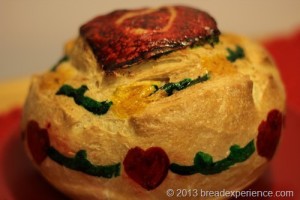
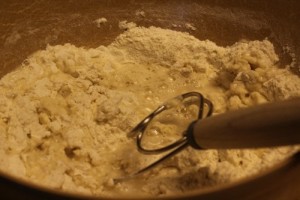
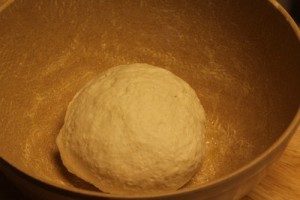
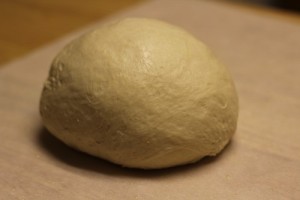
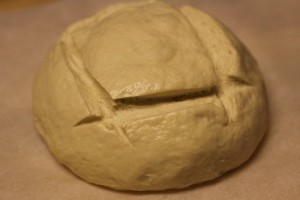
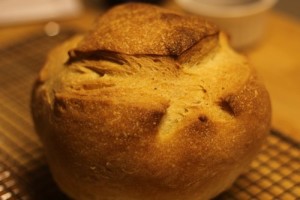
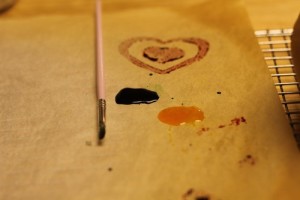
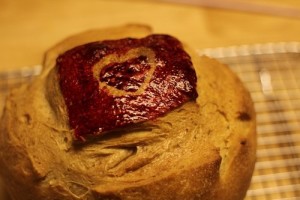
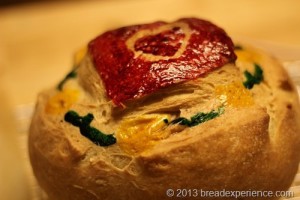
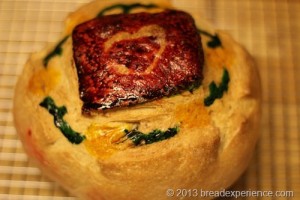
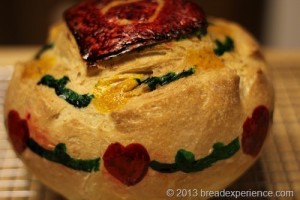
Noel Chapman says
Congrats on your 500 posts Cathy! I love the idea of painted bread and I think it would make a fun and creative way to bake bread with the kids and perfect for gift basket ideas.
Anonymous says
Many years ago an American Indian showed me this, I was the hit of many baby showers making teddy bears with the stomach craved out to fill with dip, if I knew the sex of the baby to be I would paint in those colors if not I just used both boy and girl colors. When the kids were in High School sports I would make I would make different things and would always some how bring in the school colors, my favorite was a basketball hoop made out of small dinner rolls and a basketball, the coach would have every athlete take one so they would all be a team sharing the same bread. I just love your blog with so many new and fresh ideas, thanks so much for sharing!
Anonymous says
Hi Cathy,
Congrats on your 500th post and thank you for creating such a wonderful resource here. I know I only stumbled upon your site a few weeks ago, but it has been a real inspiration. The post here is typical – who would have ever thought of painting bread! But here it is!
Thanks again and here’s to another 500!
Andrew from London
Cathy (breadexperience) says
Thanks for the words of encouragement everyone! This is what makes it all worthwhile.